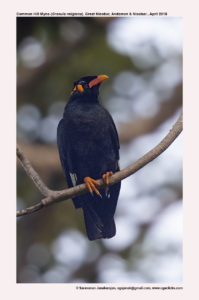
Common Hill Myna Gracula religiosa
Etymology :
- Gracula : Latin word graculus –unknown bird
- Religiosa : Latin word for sacred
Vernacular Names : Hindi: Paharimyna, Sans: Girimyna, Ben: Paharimyna, Ass: Maina, Cachar: Dao myna, Myna gashim, Mar: Pahadimyna, Ta: Malaimyna, Te: Kondagorinka, Mal: Kattumyna, Kan: Bettadagoravanka, Sinh: Selalihiniya
Distribution in India: Resident Himalayan foothills, Hills of North East , Eastern Ghats and Andaman & Nicobar Islands in India.
Description: Size of 27–31 cm; Wt. of 161–229 g. It is a large black myna with prominent bare yellow patches of skin on head. The nominate race has bare yellow patch below eye, and line of bare yellow skin from just behind eye backwards around nape, where it extends into two pendulous yellow wattles. The plumage is mostly black, with purple gloss on head, throat and mantle, and turquoise to bronzy sheen on rump and breast. The lower belly is glossy turquoise; wing is black with purple gloss, outermost large primary has white patch on inner web, primaries pp4–8 with white patch on both webs, primary p3 with white on outer web only. The iris is brown; bill is orange to red, yellow tip; legs are chrome-yellow. Both the sexes are alike. The juvenile is much less glossy, with wattles smaller. Races differ mainly in pattern of bare patches on head, in nature of glossiness of plumage, and in size: intermedia smaller than nominate, more bronzy on breast and upper back, bill is smaller, maxilla is less curved, bare skin of eye and nape joined but not extending around back of nape; peninsularis is slightly smaller than previous, with smaller and finer bill; andamensis has bare skin of eye and nape joined or only narrowly separated, white in wing sometimes extending to primary p2, bill is longer and less curved than that of nominate; batuensis is larger than nominate; palawanensis is slightly smaller than nominate, bill is shorter but deep, back, rump and underparts are more bluish and bronzy, bare patches below and behind eye are separated, wattles are slightly separated.
Habitat: It is found in regions with large trees, evergreen or deciduous, high rainfall and high humidity; edges of forest and disturbed areas, cultivated areas where large trees are maintained. Favours forest patches over dense forest. It is found from lowlands and hillsup to 2000 m .
Food habits: It eats fruit, nectar,insects and other small animal. Figs are important component of diet, and berries. Nectar is taken from flowers of Bombax, Erythrina, Grevillea and Helicteresisora. Geckos are taken on tree trunks, especially when the mynas are feeding young. It frequently feeds in flowering trees, when face becomes dusted with pollen hence it plays a role in pollination. Insects are gleaned from foliage; winged termites are hawked in flight. It is found in pairs; sometimes in flocks, occasionally large numbers gathering at fruiting trees.
Breeding habits: They breed in Apr–Jul in India, Jan–Jul in Thailand, Feb–Jul in Malaysia; Dec in Java and Aug in Philippines. They lay up to three broods per season. They are monogamous; may pair for life. The nest is built by both sexes. The nest is a pad of leaves, small twigs and feathers, with fresh leaves added during incubation, placed above ground in hole in tall tree at edge of clearing or in open area, often old hole of woodpecker or parakeet. They may nest in association with other species, e.g. Vernal Hanging-parrot. The nest is reused in successive years. They lay a clutch of 2–3 eggs. The incubation is done by both sexes, female doing greater share of the work. The incubation period is 13–17 days. The chicks are fed by both parents. The nestling period is 25–28 days. The adults begin new brood soon after young leave nest.